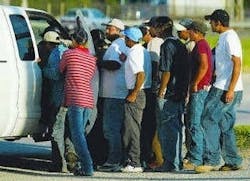Immigration Order May Shake Up Hiring
Will the President’s late-November executive order on immigration affect your business when it comes into play this spring? With so many Latino installers, many without documentation, the question for home improvement companies may be not will the order affect their business but how?
Latin Workers Close to Majority in Some Industries
The Department of Labor says Hispanics make up one out of every four workers in the U.S. construction industry. The Huffington Post puts it at 24%, though that varies by sector and region. For instance, Ricardo Gonzalez, president of Bilingual America, in the article “Things Change” on Latinos in Professional Roofing, cites a Department of Labor statistic indicating that 45.1% of workers in the roofing industry are Hispanic.
Given the preponderance of Latino installers in contracting, the first effect of the executive order may be to make more workers legally visible and, therefore, available. With unemployment now below 6% and quarterly economic growth topping 3%, residential construction companies are already running into the problem many had before the housing market’s collapse triggered the Great Recession: too few people to do the work. Already last August the National Roofing Contractors Association, in an “NRCA Action Alert,” urged members to lobby Congress for immigration reform: “The difficulty of finding sufficient workers to fill job openings continues to be a serious problem for the roofing industry, despite vigorous efforts to recruit U.S. workers.”
Why Construction’s Losing Out
But if the executive order results in an influx of newly “legal” Hispanics into the workforce, will they choose to work in construction? Maybe not.
Sarah Rumpf, in arguing for “comprehensive immigration reform” (i.e., a Congressional overhaul as opposed to the president’s executive order), notes that “90% of Texas construction companies report problems finding qualified workers, and half report losing workers to other industries, mostly the oil and gas industry.”
A slew of recent articles point to a likely reason: Construction is viewed as too dangerous. On investigative site Fair Warning, Stuart Silverstein notes that Latinos on construction jobsites are dying at higher rates than white or African American counterparts due not only to language barriers but also to a fear of reporting employers who ignore standard safety procedures, such as regular training and use of required equipment.
Experts like Gonzalez argue that fields like roofing and drywall are dominated by the “underground economy” of undocumented workers employed by Latino subcontractors who rarely train workers and have little concern for safety practices. It’s here where the preponderance of fatalities in construction occur. For exactly this reason, Konrad Putzier, in The New Republic argues that one of the biggest effects of the executive order will be “far fewer deaths on jobsites,” as workers subject to unsafe conditions will no longer be intimidated from reporting those conditions to OSHA and other regulatory authorities. “Illegal immigrants in the U.S. tend to avoid contact with authorities out of fear of being caught and deported,” he writes. “In the construction industry, this reluctance has left them with a disproportionate risk of injury or death. Fearful of reporting unsafe working conditions, they are vulnerable to negligent and abusive employers.”
Which is why Christopher Cudworth, on LinkedIn, argues that given the dangers of the job—high fall rates in roofing—and uncertainty about their status, the presidential order is a victory for compassion. But over at The Daily Beast, the feeling is that the executive order was driven less by compassion than necessity. “Whatever one thinks of the legality or propriety of President Obama’s move to end the threat of deportation for roughly five million illegal immigrants, the correct policy would be to allow more low-skilled workers to enter legally or remain in the country,” writes de Rugy.
